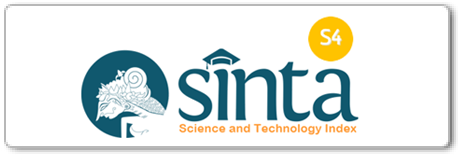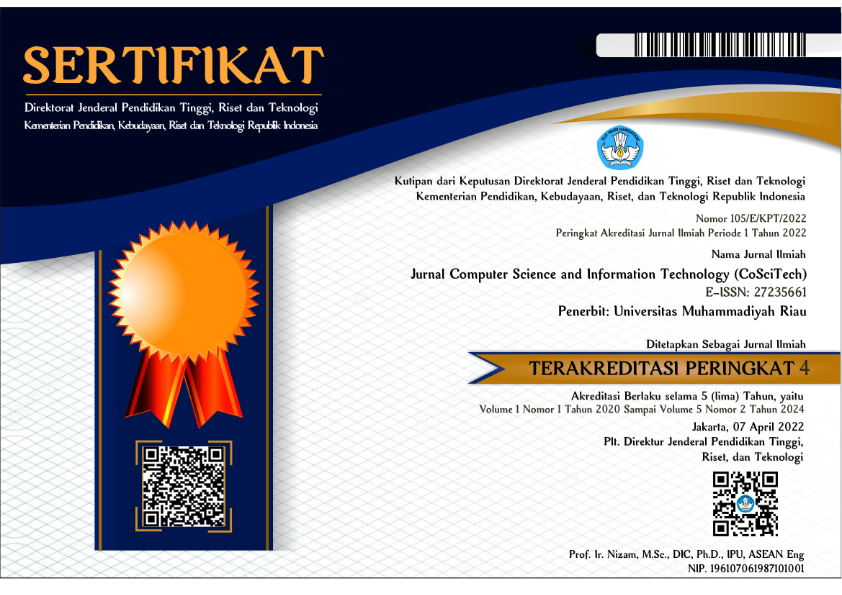Implementation of the apriori algorithm and the topsis method in determining sales patterns at mentaya hafiz furniture
DOI:
 https://doi.org/10.37859/coscitech.v4i2.5013
https://doi.org/10.37859/coscitech.v4i2.5013
Abstract
Indonesia's economic growth during the Covid-19 pandemic was not good due to low levels of public consumption. The government and MSME actors are trying to build the economy so that it can survive in all the conditions it faces. This study aims to find out how the implementation of the a priori algorithm and the TOPSIS method determine the sales pattern of a business. The analysis was carried out using two methods, namely the association rule using the a priori algorithm and the TOPSIS method as a decision support system. The analysis of the a priori algorithm produces an itemset of house frames, doors and windows as a combination that meets the 20% support value. Meanwhile, there are three association rules, namely if you buy house frames and doors, then buy windows with a confidence value of 100% and a lift ratio of 1.89. It's the same as the other 2 rules which produce a lift ratio value of more than 1, which means the rule is valid. In the analysis of the TOPSIS method, of the 22 alternatives it is known that alternative A14, namely windows, is ranked 1st as the product that sells the most, followed by alternative A13, namely doors. In addition, there are several products that have the same preference value so that they are also in the same rank, such as cafe chairs, stakes/stones and flower shelves then cafe tables and shoe racks.
Downloads
References
[2] Kemenko Perekonomian, “Perkembangan UMKM sebagai Critical Engine Perekonomian Nasional Terus Mendapatkan Dukungan Pemerintah,” Kementeri. Koord. Bid. Perekon., 2022.
[3] Kemenkeu, “PIP Dukung Penguatan Kontribusi UMKM terhadap Ekonomi Indonesia,” Pip.Kemenkeu.Go.Id, 2022. .
[4] A. P. Barčić, M. K. Kuzman, T. Vergot, and P. Grošelj, “Monitoring consumer purchasing behavior for wood furniture before and during the covid-19 pandemic,” Forests, vol. 12, no. 7, 2021, doi: 10.3390/f12070873.
[5] Y. Suhaety, M. Mulyati, and M. Fadillah, “Analisis Strategi Pengembangan Usaha Mebel Samawa di Kandai 2 Kecamatan Woja,” Ainara J. (Jurnal Penelit. dan PKM Bid. Ilmu Pendidikan), vol. 2, no. 3, pp. 281–287, 2021, doi: 10.54371/ainj.v2i3.93.
[6] A. N. Rahmi and Y. A. Mikola, “Implementasi Algoritma Apriori Untuk Menentukan Pola Pembelian Pada Customer (Studi Kasus : Toko Bakoel Sembako),” Inf. Syst. J., vol. 4, no. 1, pp. 14–19, 2021, [Online]. Available: https://jurnal.amikom.ac.id/index.php/infos/article/view/561.
[7] U. Ependi and A. Putra, “Solusi Prediksi Persediaan Barang dengan Menggunakan Algoritma Apriori (Studi Kasus: Regional Part Depo Auto 2000 Palembang),” J. Edukasi dan Penelit. Inform., vol. 5, no. 2, p. 139, 2019, doi: 10.26418/jp.v5i2.32648.
[8] M. U. Albab and D. Hidayatullah, “Penerapan Algoritma Apriori pada Sistem Informasi Inventori Toko,” J. Media Inform. Budidarma, vol. 6, no. 3, p. 1321, 2022, doi: 10.30865/mib.v6i3.4160.
[9] D. Setiawan, E. Sediyono, and I. Sembiring, “Pemanfaatan Metode Association Rules dan Holt-Winter Multiplicative untuk Meningkatkan Peluang Penjualan Obat Pertanian,” J. Sist. Inf. Bisnis, vol. 10, no. 1, pp. 46–55, 2020, doi: 10.21456/vol10iss1pp46-55.
[10] O. Manurung and P. S. Hasugian, “Analisa Algoritma Apriori Untuk Peminjaman Buku Pada Perpustakaan SMA 1 Silima Pungga-Pungga Parongil,” Remik, vol. 4, no. 1, pp. 154–160, 2019, doi: 10.33395/remik.v4i1.10445.
[11] I. A. Ashari, A. Wirasto, D. Nugroho Triwibowo, and P. Purwono, “Implementasi Market Basket Analysis dengan Algoritma Apriori untuk Analisis Pendapatan Usaha Retail,” MATRIK J. Manajemen, Tek. Inform. dan Rekayasa Komput., vol. 21, no. 3, pp. 701–709, 2022, doi: 10.30812/matrik.v21i3.1439.
[12] I. M. D. P. Asana, I. G. I. Sudipa, A. A. T. W. Mayun, N. P. S. Meinarni, and D. V. Waas, “Aplikasi Data Mining Asosiasi Barang Menggunakan Algoritma Apriori-TID,” INFORMAL Informatics J., vol. 7, no. 1, p. 38, 2022, doi: 10.19184/isj.v7i1.30901.
[13] D. J. Utari, G. W. Nurcahyo, and Y. Yunus, “Sistem pendukung keputusan menggunakan metode analytical hierarchy process (ahp) dalam penentuan kualitas bibit cabai,” J. CoSciTech (Computer Sci. Inf. Technol., vol. 4, no. 1, pp. 106–115, 2023.
[14] M. R. Aprillya and U. Chasanah, “Sistem Pendukung Keputusan Identifikasi Daerah Rawan Kekeringan dengan Metode Fuzzy Analytical Hierarchy Process (Studi Kasus: Kabupaten Lamongan),” J. CoSciTech (Computer Sci. Inf. Technol., vol. 3, no. 2, pp. 159–167, 2022, doi: 10.37859/coscitech.v3i2.3983.
[15] E. B. Saputro and A. H. S. Jones, “Sistem Pengambilan Keputusan Penentuan Pemasok Obat Pada Apotek Al Fayadh Farma Yogyakarta dengan Metode Topsis,” JSTIE (Jurnal Sarj. Tek. Inform., vol. 8, no. 3, p. 93, 2020, doi: 10.12928/jstie.v8i3.17702.














